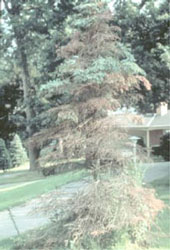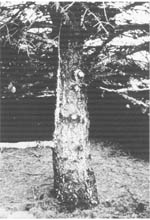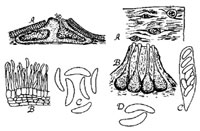Reports on Plant Diseases |
RPD No. 604 - Cytospora or Leucostoma Canker
of Spruce
|
April 1996
|
[ Symptoms and Signs ] [ Disease
Cycle ] [ Control ]
|
Cytospora or Leucostoma canker, the most common and damaging disease
of spruce, is caused by the fungus Leucocytospora kunzei,
synonym Cytospora kunzei (teleomorph or sexual state Leucostoma
kunzei, synonym Valsa kunzei). This canker occurs
on several conifers from New England to the western United States. Colorado
or Colorado blue (Picea pungens) and Norway spruce (Picea
abies), used for ornament and in wind-breaks, are the species
most commonly affected in Illinois. The disease has reached epidemic proportions
on Engelmann spruce (Picea engelmannii) and Douglas-fir
(Pseudotsuga menziesii) in the eastern Rocky Mountains due
to a succession of dry years in the area. Other trees reported as susceptible
to the disease are given in Table 1.
Spruce trees less than 10 to 15 years old usually do not have Cytospora
canker. In landscape nurseries, however, small branches of young
Colorado blue and occasionally white spruces may be killed. Three varieties
of Leucostoma kunzei are recognized by some specialists:
var. piceae on spruces, var. superficialis
on pines, and var. kunzei on other conifers.
|
Click on image for
larger version

Figure 1. Colorado
spruce
affected by Cytospora canker.
|
Dead and dying branches call attention to Cytospora or Leucostoma canker with
older branches more susceptible than young ones. The fungus kills areas of bark,
usually at the bases of small twigs and branches, creating elliptical to diamond-shaped
lesions. If the lesions enlarge faster than the stem and girdle it, the portion
beyond the canker also dies. The disease normally starts on the lowest branches
and slowly progresses to higher branches (Figure 1).
The entire tree is rarely killed except when the trunk is girdled. In most conifers,
the cankers are usually confined to the branches. Black, Engelmann, Norway,
red, and white spruce trees develop trunk cankers more often than other affected
species. In Illinois, Cytospora canker destroys the ornamental value of spruce
trees by killing branches and causing profuse exudation of resin from cankers
on branches or trunks (Figure 2 and Figure
3).
Back to Top
Symptoms and Signs
In spring and early summer, the needle tufts at the tips of one or more branches
fades and turns brown; the next symptom is death of the lower branches (Figure
1). Occasionally, the lower branches remain healthy and those at the center
or top of a tree are attacked and killed. The brown needles may drop early from
affected branches but usually persist for several months before dropping off
during winter, leaving dry, brittle twigs and branches. This process recurs
more or less each year moving from the older lower branches to younger higher
ones destroying the symmetry of ornamental trees.
|
Unlike cankers on many plants, Cytospora cankers on spruce do not usually
discolor the outer bark or cause it to become depressed. Clear amber resin
exudes in large amounts from the edges of cankers, flows down the bark,
or drips onto the lower branches and trunk or ground and hardens in patches
into a conspicuous white crust (Figure 2 and
Figure 3). Several years, or sometimes a decade
or more may pass before a trunk or large limb is completely girdled and
killed. By that time the stem may be deformed because of one-sided growth
and diseased tissue beneath the thin layer of outer bark is brown to reddish
brown and infiltrated by resin. The underlying sapwood is colonized and
killed by the fungus but is scarcely discolored. Black, pinhead-size,
spore-producing bodies or stromata (pycnidia and perithecia) form in the
dead inner bark near the edge of the cankers. The stromata are a positive
sign of the disease. The fruiting bodies expand and are easier to see
if the cankered stem is wrapped in a wet towel for 24 hours.
|
Click on image for
larger version

Figure 2. Cytospora
canker on
spruce is usually indicated by
conspicuous white deposits or
encrustations of resin on the bark
(IL Nat. Hist. Survey photo)
|
Mite injury can cause some of the same symptoms as Cytospora canker. To check
for mites, hold a white sheet of paper or a handkerchief under a branch and
sharply rap the stem. If mites are present, some should be seen crawling on
the paper or handkerchief.
Back to Top
Disease Cycle
Click
on image for larger version

Figure 3. White
resin flow
on spruce, symptom of
Cytospora canker
(Purdue University photo) |
The causal fungus survives as mycelium and spores in diseased and dead
stems. The cankers grow slowly in size, eventually encircling and killing
the twig or branch. As the fungus grows, it produces two kinds of spore-producing
stromata which cannot be distinguished without a microscope: the perithecia
of the sexual or teleomorph state, Leucostoma or Valsa
kunzei (Figure 4, right), and the pycnidia
of the asexual or anamorph state, Leucocytospora or Cytospora
kunzei (Figure 4, left).
Pycnidial stromata, which are much more abundant than the perithecial
stromata, are 1 to 2 millimeters (mm) in diameter with fertile chambers
radiating from the center and opening to the bark surface by a common
pore at the top of the stroma (Figure 4 left, A).
When wet, the pycnidial stromata absorb water, swell, and exude millions
of microscopic spores or conidia (Figure 4 left,
C) in long, curled, amber to orange, sticky tendrils. An individual
stroma exudes its pores only once. Conidial production is greatest during
spring but the release of spores occurs throughout spring, summer, and
autumn. The conidia can withstand freezing and germinate at temperatures
of 68° to 91.4° F (20° to 33° C). The optimum temperature
for conidial germination and growth is near 81 ° F (27 ° C).
|
Perithecial stromata, which mature during spring, are 1 to 2 mm in diameter,
gray to black on the surface, and found in dead bark beyond the cankers. Five
to 30 perithecia are embedded in the pale yellow to grayish brown tissue of
a stroma (Figure 4 right, A and B). The long necks
of the perithecia converge at the disclike top of the stroma (Figure
4 right, B). The microscopic spores (ascospores,
Figure 4 right, D) are released during wet periods in spring and early summer.
The conidia and ascospores are dispersed in wet weather by splashing rain and
wind; they may also be dispersed by pruning tools, tree workers' hands and clothing,
and by the movement of insects. The two types of spores are the principal means
by which the infection is spread to other branches and trees. Infection of both
types of spores occurs through bark wounds resulting from injuries or other
openings in the tree stems. Most infections are presumed to occur in wet weather
in early spring when both conidia and ascospores are abundant, and shortly before
symptoms appear. Tiny breaks in the outer bark, caused by mechanical stress
such as the weight of ice and snow, are possible sites for infection. The fungus
can also be found in the outer bark of apparently healthy twigs and branches.
|
Canker development is most severe if the tree has been under stress that
is limiting its growth. Drought, insect damage, root-feeding nematodes,
crowding, nutrient imbalance, hail, and other forms of mechanical damage
to the branches, trunk, or roots predispose trees to infection. The susceptibility
varies widely among species of spruce. Spruces growing outside their natural
geographical range are generally more susceptible than native species.
In Wisconsin, for example, Colorado and Norway spruce trees often develop
the disease, while the native black and white spruces are rarely infected.
No species of spruce is native to Illinois. Inherent susceptibility varies
among individual trees as well as among species.
Back to Top
|
Click on image for
larger version

Figure 4. Figure
4. Cytospora kunzei
(left) under high-power microscope.
Leucostoma (Valsa) kunzei (right).
(Lenore Gray drawing).
|
Control
-
Plant healthy, vigorous, young spruces on sites favorable for their
growth. Avoid planting in shallow or excessively drained soils—for example,
in light, sandy, or gravelly soils. Avoid crowding with other trees or buildings.
If possible, do not plant in exposed sites such as a southwest-facing slope.
A thick (4 to 6 inches), organic mulch helps maintain good soil moisture
and prevents deep freezing, alternate freezing, and thawing. Avoid making
unnecessary bark wounds. During extended dry periods, water thoroughly,
moistening the soil to a depth of 12 to 14 inches. To help stimulate vigorous
growth, take a soil test and apply fertilizer every few years.
-
Severely cankered trees cannot be restored to good health. These
trees should be cut down and burned because they are a source of infection
for other trees. On less severely diseased trees, all diseased and adjacent
branches should be pruned back to the nearest living lateral branch or to
the trunk. On major limbs or trunks, it is sometimes possible to cut out
cankered parts. First, remove all brown, diseased tissue and 1 inch of apparently
healthy bark and wood on all sides, cutting to a depth of 1/4 inch. Carefully
clean your tools and disinfect them by swabbing or immersing them in a solution
of 70 percent rubbing alcohol. Finally, scrape away the margins from the
previous cut and shape the wound. Do NOT prune or work around trees when
the foliage, twigs, and branches are wet.
- No chemical treatment has been shown to effectively prevent or arrest
the development of cytospora or leucostoma canker on spruce trees.
For further information concerning spruce or other woody plants, contact
Nancy R. Pataky, Extension Specialist of Turf and Ornamentals, and Director
of the Plant Clinic, Department of Crop Sciences, University of Illinois, Urbana-Champaign.
Back to Top
|



